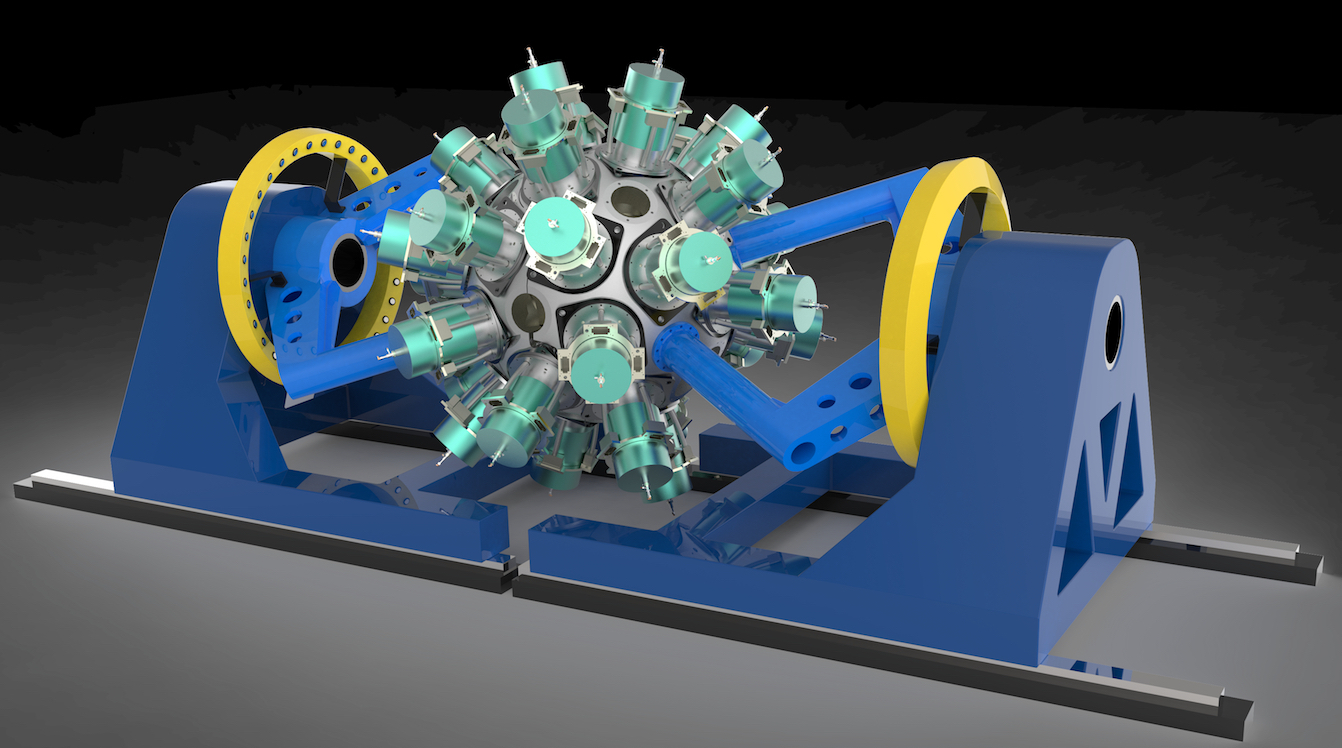A new high-resolution gamma-ray detector system – designed to reveal new details about the structure and inner workings of atomic nuclei, and to elevate our understanding of matter and the stellar creation of elements – has passed an important project milestone.
When this system – the Gamma-Ray Energy Tracking Array, or GRETA – is combined with an existing detector array called GRETINA (for Gamma-Ray Energy Tracking In-beam Nuclear Array), it will create a full spherical array. Gamma rays are highly penetrating, highly energetic forms of light that are emitted from excited nuclear states.
GRETINA was completed in 2011 and has demonstrated the power of a gamma-ray tracking detector for nuclear physics. The U.S. Department of Energy’s Lawrence Berkeley National Laboratory (Berkeley Lab) has had a leadership role in GRETINA and now GRETA. The GRETA project includes researchers at Argonne and Oak Ridge national laboratories and at Michigan State University.
Once complete, the detector system will reside first at Michigan State University’s Facility for Rare Isotope Beams (FRIB), a future DOE Office of Science User Facility that is under construction. FRIB will support the DOE Office of Science’s mission.
“GRETA will be a flagship instrument and a major workhorse for science at FRIB,” said Paul Fallon, GRETA project director and a senior staff scientist at Berkeley Lab.
GRETA will be used to study nuclear reactions in real time. It can study the creation of new nuclei as a high-energy beam smacks a target, for example – and detail the path of individual gamma rays through the detector, which is useful for reconstructing events to learn more about the properties of the event that triggered it.
“GRETA will have up to 100 times greater sensitivity than existing detectors for certain experiments,” Fallon added. “It will have both a high-efficiency and a high-energy resolution in measuring gamma-ray energies.”
Experiments that utilize GRETA will help to establish the limits on how many protons and neutrons can pack into an atomic nucleus and determine the structure of atomic nuclei.
Barbara Jacak, director of Berkeley Lab’s Nuclear Science Division, said, “GRETA will allow us to measure how the structure changes when the number of protons or neutrons is much larger than that in stable isotopes.” She added, “The nucleus is the prototypical quantum many-body system” – it is home to many complex particle interactions involving a quantum phenomenon known as entanglement.
GRETA could also help to establish the properties of nuclei that govern how explosive star deaths can seed the universe with a variety of heavy elements.
“We want to know: How are elements heavier than nickel or iron produced in the so-called rapid neutron-capture process or ‘r-process’ after stars like our sun have collapsed in their life cycle?” said Alan Poon, deputy division director for Nuclear Science at Berkeley Lab.
The latest project milestone, which followed a Department of Energy-mandated review and approval stage, sets in motion the engineering design phase of the project and provides for the purchase of some detector modules. These modules feature ultrahigh-purity germanium crystals – each about the size of a 10-ounce coffee cup – that are integral to the GRETA design.
At FRIB, powerful beams of charged particles (ions) will be accelerated to half the speed of light by a powerful linear accelerator.
These beams will strike nuclear targets within a chamber surrounded by the GRETA array, producing an assortment of elements in their many forms, called isotopes. Many of these elements and their isotopes are not found in nature and exist for only fractions of a second before they decay into more stable nuclei. Isotopes are versions of elements that have different atomic masses based on the varying number of neutrons they carry.
The GRETA detector array is designed to surround samples, forming a spherical shell to more completely and precisely measure the energy and 3D position of gamma rays propagating in the detectors. The array will feature 120 germanium crystals arranged in 30 modules. It will incorporate 12 GRETINA detector modules.
Each detector crystal will be fashioned into two separate designs that have a tapered, irregular hexagon shape and are about 3.5 inches in length.
“The real trick is to take these crystals and pack them very closely together, within a couple of millimeters, and to rapidly record the digitized gamma-ray signals,” Fallon said.
The project requires ultrafast electronics to record these gamma-ray events. The front-end electronics will be able to capture up to 50,000 signals per second in each crystal, and the instrument will require a petabyte of storage to capture the rapid-fire data. A 5,000-core computing cluster will help to process these signals in real time.
A majority of the experiments at FRIB are expected to use GRETA in some form. Some of the experiments will use samples that are designed to stop the beam from penetrating through, and others will study accelerated beams that pass through samples.
The experimental results will be matched up against theoretical calculations in nuclear reactions and nuclear structure to see whether long-held predictions must be revised.
The GRETA project is supported by the U.S. Department of Energy’s Office of Science.
###
Lawrence Berkeley National Laboratory addresses the world’s most urgent scientific challenges by advancing sustainable energy, protecting human health, creating new materials, and revealing the origin and fate of the universe. Founded in 1931, Berkeley Lab’s scientific expertise has been recognized with 13 Nobel Prizes. The University of California manages Berkeley Lab for the U.S. Department of Energy’s Office of Science. For more, visit www.lbl.gov.
DOE’s Office of Science is the single largest supporter of basic research in the physical sciences in the United States, and is working to address some of the most pressing challenges of our time. For more information, please visit the Office of Science website at science.energy.gov.
